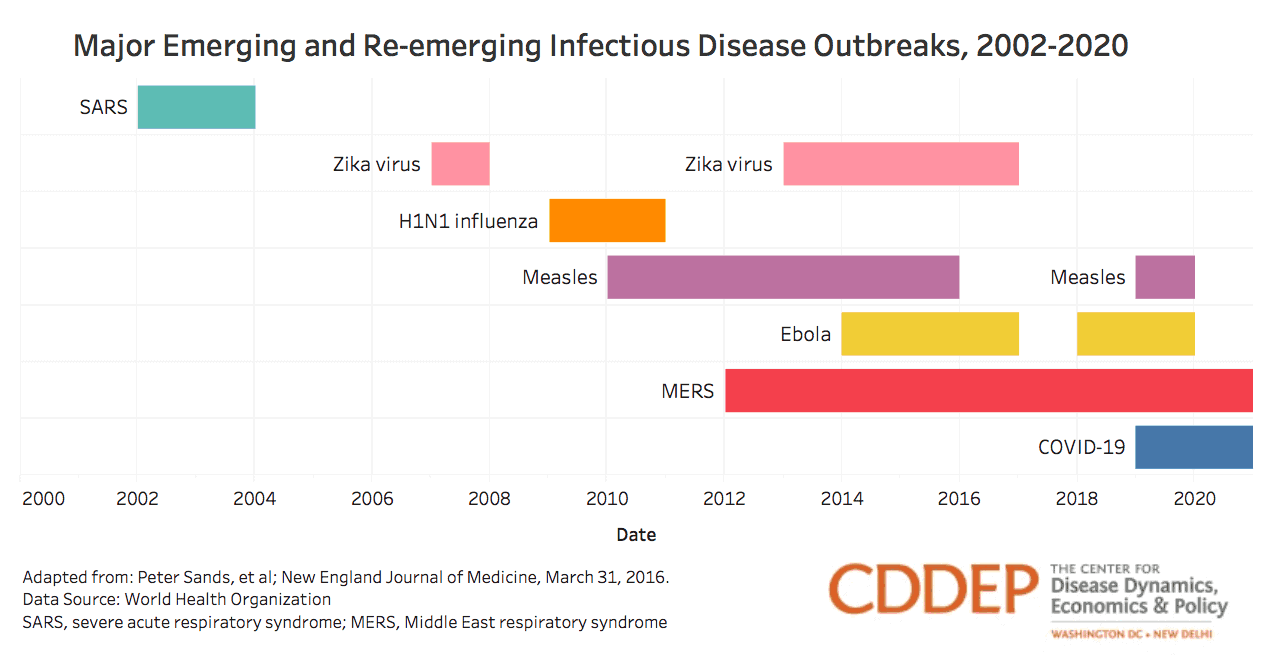March 09, 2020

Pandemic preparedness is essential as the world becomes more susceptible to disease. In a 2017 article published in the Milken Institute Review, CDDEP director Ramanan Laxminarayan emphasizes the importance of pandemic preparedness. He highlights the irony of how new outbreaks of infectious disease often lead to billions of dollars in funding as well as the shutdown of trade and travel, while continued health threats like malaria and antimicrobial resistance (AMR) are often overlooked by the general public. Infectious disease outbreaks pose a threat to the global economy and can wipe out decades of growth in countries with weak health systems and infrastructure. The increasing mobility of humans, rapid production of food animals, and the threat of climate change are making the world more susceptible to disease, and increasing the likelihood of future pandemics. Laxminarayan recommends implementing stronger incentives for pandemic preparedness and outbreak reporting, as well as establishing a global insurance fund to cover countries against pandemic-related economic losses. [Milken Institute Review, CDDEP]

COVID-19 cases slow in China as virus takes hold in other countries worldwide. As of March 9, 2020, there have been nearly 110,000 cases of COVID-19 and 3,809 deaths reported across 100+ countries worldwide. The World Health Organization (WHO) is expected to declare the situation a pandemic once community spread of the virus becomes rampant outside of China. South Korea (7,382 cases), Italy (7,375 cases), and Iran (6,566 cases) currently have the largest outbreaks of COVID-19, preceded by China. Italy has placed nearly 16 million people on lockdown and canceled all public events in northern regions in an attempt to control the virus. [WHO, CNN, NYTimes]
Only 23% of countries report using antimicrobials in food animals, OIE report finds. In the fourth Annual Report on Antimicrobial Agents Intended for Use in Animals, the World Organization for Animal Health (OIE) finds that, as of 2018, 118 out of 153 countries included in the report (77 percent) did not report using any antimicrobial agents as growth promoters in food-producing animals. Of the remaining countries, 20 reported the use of regulations that guide which antimicrobials should or should not be used in animals. In an analysis that controlled for animal biomass across 92 countries, the OIE estimated that 144.39 mg/kg of antimicrobials were used in animals globally in 2016. [OIE]
Antibiotic treatment failure common among US adults with pneumonia. Researchers conducted a retrospective analysis including more than 250,000 US patients with community-acquired pneumonia (CAP) and found that 22.1 percent of them experienced antibiotic treatment failure. Treatment failure was more common in patients 65+ than those aged 18-64 years old (25.7 vs. 21.2 percent) and was linked to healthcare costs of $2,140 per patient. The study also found that all-cause mortality was 18.1 percent among patients who experienced antibiotic failure, compared to 4.6 percent among patients who did not. [Open Forum Infectious Diseases]
Acid suppressants may increase risk of MDRO colonization. A systematic review and meta-analysis found a strong link between the use of acid suppressants and the risk of intestinal carriage of multidrug-resistant microorganisms (MDROs). In a pooled analysis of 26 studies including 29,382 patients, researchers found that acid suppressant use significantly increased the odds of Enterobacterales order and vancomycin-resistant enterococci MDRO carriage (aOR = 1.60, 1.97 respectively). The authors suggest that reducing inappropriate use of acid suppressants may be a key strategy in improving antimicrobial stewardship. [JAMA Internal Medicine]
ProMED and Public Health England to launch global AMR surveillance network. The International Society for Infectious Diseases’ (ISID) Program for Monitoring Emerging Diseases (ProMED) is partnering with Public Health England in an effort to improve global surveillance of antimicrobial resistance (AMR). The organizations plan to create a surveillance network comprised of global data on resistance trends and AMR hotspots in humans, animals, and the environment worldwide. The network will be updated continuously and will be free to users. [ISID]
Treatment for complicated UTIs now available in United States. A new antibiotic treatment for complicated urinary tract infections (UTIs) is now available in the United States, according to a press release from manufacturer Shionogi & Co. Cefiderocol was approved by the US Food and Drug Administration (FDA) in November 2019 to treat resistant UTIs caused by gram-negative bacteria in patients 18 years and older. [Shionogi, FDA]
ACIP votes to recommend Ebola vaccine for at-risk US healthcare workers. The US Centers for Disease Control and Prevention (CDC) Advisory Committee on Immunization Practices (ACIP) voted unanimously (14-0) to recommending Ebola vaccination for at-risk US healthcare workers. Ervebo is a live attenuated vaccine that was approved by the US Food and Drug Administration (FDA) in December 2019 to prevent Ebola virus infection among individuals 18 years and older. The ACIP recommendation applies to US healthcare and laboratory workers responding to Ebola outbreaks or working at federally-designated Ebola Treatment Centers and biosafety-level 4 facilities in the United States. [MedPage Today, CIDRAP]
Study finds US flu vaccine effective in preventing child hospitalizations as pediatric flu deaths spike. The US Centers for Disease Control and Prevention (CDC) reported a drop in influenza cases last week, from 5.5 t0 5.3 percent. According to a systematic review and meta-analysis of 28 studies, the US flu vaccine is 57.5 percent effective in preventing hospitalizations among children 6 months to 17 years old. The study estimated that the overall vaccine effectiveness was high among children five years and younger (61.71 percent), as well as children 6-17 years old (54.37 percent). So far this season, there have been more influenza-related pediatric deaths (136) than any other flu season since reporting began, with the exception of the 2009 H1N1 pandemic. [CDC, Vaccine]
Resistant pneumococci strains in children have shifted post PCV-13 introduction. New York researchers identified an increase in pneumococcal antibiotic resistance among US children between 2013 and 2016. Pneumococcal resistance decreased initially following the introduction of the 13-valent pneumococcal conjugate vaccine (PCV-13) in 2010, however, resistance has emerged in new strains not included in the vaccine. In the analysis of 1201 Streptococcus pneumoniae isolates from children 6 to 36 months, researchers observed a decrease in pneumococcal susceptibility to penicillin, third-generation cephalosporins, fluoroquinolones, and carbapenems. [Clinical Infectious Diseases]











